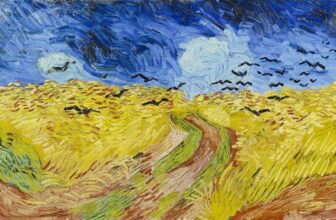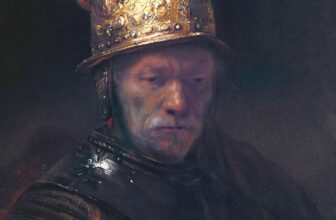Meaning of Magdalene with the Smoking Flame by Georges de La Tour
In the quiet hush of a dimly lit room, a woman sits in solemn contemplation. Her head gently bowed, her face illuminated by the warm flicker of a lone candle, she stares into the void, between life and death, sin and redemption, flesh and spirit. This is Magdalene with the Smoking Flame, a hauntingly beautiful painting by 17th-century French Baroque artist Georges de La Tour.
De La Tour’s rendering of Mary Magdalene is a window into the human soul and its capacity for transformation. Created around 1640, this masterpiece continues to draw the gaze of art lovers, theologians, and seekers alike, each searching for answers in the symbols and shadows cast by the flame.
A Quiet Revolution in Paint
Georges de La Tour (1593–1652), often referred to as “the master of candlelight,” was a unique figure in the Baroque era. Unlike his more flamboyant contemporaries like Caravaggio and Rubens, La Tour brought stillness, introspection, and mystery into his paintings. He rarely painted dramatic narratives. Instead, he focused on psychological depth, on mood, and above all, on the divine presence lurking in silence.
“Magdalene with the Smoking Flame” is one of several versions La Tour created of the penitent Magdalene, a figure who fascinated both artists and theologians in the 17th century. In this particular composition, Magdalene is depicted in a darkened room, seated quietly beside a small table. Her bare arms rest gently on her lap, and she holds a skull with tender, almost maternal, care. A single candle burns low, and its flame emits a soft smoke that curls into the darkness above.
At first glance, the painting feels simple. But look longer, and its symbols start to whisper.
Who is Mary Magdalene in the Painting?
To understand the painting, we must first understand the subject: Mary Magdalene. Historically, she is a figure shrouded in both reverence and controversy. In the New Testament, Magdalene is portrayed as a devoted follower of Jesus, present at both his crucifixion and resurrection. She is often described as the first witness of the resurrection, a status that has led many to call her “the Apostle to the Apostles.”
However, over the centuries, especially through the influence of Pope Gregory I in the 6th century, Mary Magdalene became conflated with other biblical women, namely, the unnamed sinner who anoints Jesus’ feet. This interpretation cast her as a reformed prostitute, a narrative that persisted in Christian art and theology for centuries.
By the time Georges de La Tour painted her, Mary Magdalene was a complex symbol: a woman who had fallen into sin but found redemption through grace. She became the embodiment of penitence, of turning away from worldly vanity and toward spiritual truth.
It is this penitent Magdalene that La Tour offers us, not weeping at the feet of Christ, but alone, deep in thought, in communion with mystery.
The Skull: A Memento Mori
Why is Magdalene holding a skull?
In Christian art, the skull is a memento mori, a Latin term meaning “remember you must die.” It serves as a reminder of mortality, of the inevitable end that awaits all earthly life. By holding the skull so gently, Magdalene is not recoiling from death, but embracing its meaning.
This is not a gesture of despair; it is one of acceptance and awakening. For Magdalene, the skull represents the end of her old life, her past sins, her attachment to the world, and the beginning of her spiritual transformation.
The skull also symbolizes wisdom. In Christian mysticism, knowledge of one’s mortality leads to true wisdom: it clears the fog of vanity and brings the soul closer to the eternal.
Magdalene, in this painting, is not mourning her death, but contemplating the truth it holds.
The Smoking Flame: A Symbol of the Soul
The candle is the beating heart of this painting. Lit but near exhaustion, its flame curls into smoke that spirals into the void above. Why did La Tour focus on this fragile flame?
The candle symbolizes life, the human soul, and the transient nature of existence. It burns steadily, illuminating the room, even as it dwindles into smoke. Like life itself, it is both radiant and fleeting.
In Catholic tradition, candles are also used to represent prayers offered to God, each flame a symbol of faith reaching toward the divine. The presence of the smoking flame suggests that Magdalene is caught between these two worlds, earthly and spiritual, presence and absence, light and darkness.
The smoke, in particular, adds another layer of meaning. It signals that the flame is dying, that life is passing. But smoke also rises, it reaches up, like the soul ascending from the body. In this way, the painting becomes a meditation on death not as an end, but as a passage.
A Still Life of the Spirit
Georges de La Tour doesn’t fill the canvas with elaborate background details or multiple characters. Instead, he gives us Magdalene alone with her symbols: the candle, the skull, a book, and a rope lying on the floor.
Each of these items is intentional.
The Book likely represents the Holy Scriptures, the Word that guides her transformation.
The Rope, often associated with self-discipline or penitence in Christian iconography, hints at her past austerity or her inner struggle with sin.
The Mirror (in some versions of the painting) could represent vanity, now cast aside.
La Tour creates a composition that is at once quiet and monumental. It is a still life of the soul, a painting that doesn’t move, but stirs movement within the viewer.
Light and Shadow: A Spiritual Drama
La Tour’s mastery of light is essential to the painting’s power. He uses chiaroscuro, the dramatic interplay of light and dark, to heighten the spiritual drama. But unlike Caravaggio, whose chiaroscuro is violent and theatrical, La Tour’s light is soft, controlled, and intimate.
The candlelight bathes Magdalene’s face, casting soft shadows around her eyes and cheekbones. The darkness around her is not oppressive but contemplative. It invites the viewer inward, toward silence, toward introspection.
This use of light and shadow mirrors the spiritual journey itself, from the darkness of sin into the illumination of grace.
Magdalene’s Posture and Expression
Magdalene’s body language is deeply telling. She sits with her legs turned slightly inward, her shoulders relaxed. Her head rests gently on her hand, as if in a moment of vulnerable reflection. Her gaze is not focused on the viewer, nor on the skull or candle, but somewhere beyond, alluding to a deep interior landscape.
This is not a theatrical moment; it’s an internal one. We, as viewers, are not witnesses to a public act of repentance. We are intruding on a private moment of spiritual transformation.
In a world obsessed with action and performance, La Tour’s Magdalene speaks to the quiet, radical power of contemplation.
A Counterpoint to Vanitas
Art in 17th-century Europe often included “vanitas” themes, still life compositions reminding viewers of the fleeting nature of beauty, youth, and wealth. Common motifs included wilting flowers, extinguished candles, timepieces, and skulls.
La Tour adopts these motifs but transcends them. While Magdalene with the Smoking Flame includes traditional vanitas symbols, it is not nihilistic. Instead, it suggests that awareness of death can be the beginning of true life.
Rather than warning the viewer of life’s futility, La Tour offers hope: that the soul, through self-reflection and grace, can rise above transience.
The Location Today
Today, Magdalene with the Smoking Flame resides in the Los Angeles County Museum of Art (LACMA). It is considered one of the jewels of their European painting collection.
The journey of this painting to LACMA is itself a story of rediscovery. For many years, Georges de La Tour’s work was forgotten. He was rediscovered in the early 20th century, when scholars began to reevaluate the subtle power of his paintings. Since then, he has been recognized as one of the great masters of Baroque art, distinct in his quietude, luminous in his spiritual depth.
Visitors to LACMA can now stand before the painting and experience firsthand what centuries of viewers have felt: that mysterious pull into another world, lit only by a single flame.
Why Does This Painting Still Matter?
In an age of noise, distraction, and spectacle, Magdalene with the Smoking Flame offers something radically different: silence.
It reminds us that transformation doesn’t always happen in public, or through grand gestures. Sometimes, the deepest changes occur in solitude, by candlelight, in the stillness of night.
The painting invites us to ask uncomfortable but necessary questions:
What are we holding onto that no longer serves us?
Are we living in alignment with our deepest truths?
What might we learn from sitting in silence with ourselves?
As Mary Magdalene contemplates her mortality, we are reminded of our own. But we are also reminded that death is not the final word. There is grace in letting go, in sitting with the shadows, in trusting that the soul, like the smoke of the flame, rises.
Georges de La Tour’s Magdalene with the Smoking Flame is more than a painting, it’s a meditation. Through Magdalene’s quiet gaze, the candle’s gentle glow, and the ever-present skull, we are brought into a sacred space of reflection.
In her solitude, we find our own. In her silence, our questions echo louder. And in the dying flame, we glimpse the light that endures.
So next time you’re faced with darkness, remember Magdalene. Sit quietly. Hold the skull. Watch the flame. And listen. The soul speaks in silence.




